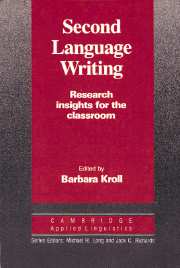I - PHILOSOPHICAL UNDERPINNINGS OF SECOND LANGUAGE WRITING INSTRUCTION
Published online by Cambridge University Press: 05 October 2012
Summary
Section I presents several chapters which jointly address many of the paramount concerns of the second language writing teacher or researcher who must consider, among other issues, the classroom and the institutional setting of writing courses, the writer and the process of writing, the teacher and his or her responses to writing produced by students, and the written text as a meaning-making event that exists as a component of literacy skills in general. Among the questions the authors of these chapters address are some of the most important and yet complex in the field today.
How has the teaching of ESL writing evolved in the second half of the twentieth century?
Chapter 1, by Tony Silva, traces the history of second language writing instruction in terms of how writing has been viewed within the English as a second language (ESL) curriculum from the 1940s until the 1990s, focusing particularly on how the teaching of writing has changed during the same period. In reviewing the controlled composition model, current-traditional rhetoric, the process approach, and English for academic purposes, Silva provides a diachronic view of composition instruction that can additionally serve to help teachers evaluate curricula and materials in a larger historical framework. Silva's chapter also addresses theory building in the field, and he provides a proposed model within which to view the relationship between theory, research, and practice by focusing on several “givens” of many typical second language classrooms: the L2 writer, the L1 reader, the L2 text, and the L1 context.
- Type
- Chapter
- Information
- Second Language Writing (Cambridge Applied Linguistics)Research Insights for the Classroom, pp. 7 - 10Publisher: Cambridge University PressPrint publication year: 1990



